Lightning 1976-1979 car-by-car histories
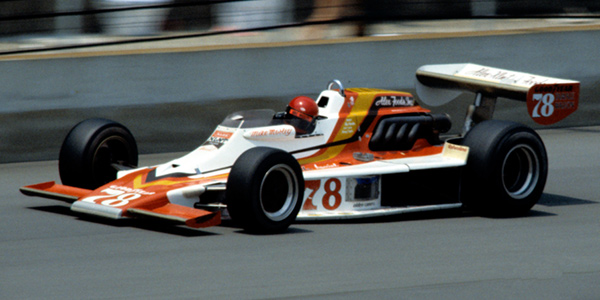
Mike Mosley in Alex Morales' Lightning at the Indy 500 in 1978. Copyright Glenn Snyder 2014. Used with permission.
Designed by Roman Slobodynskyj for Lindsey Hopkins in 1976, the prototype Lightning was very fast but the production models built for 1977 did not achieve the expected results.
Following the disappointment of Bob Riley's 1974 design, Lindsey Hopkins hired former Eagle designer Roman Slobodynskyj to create a new car for the team for 1976. Slobodynskyj took advantage of USAC's new fuel cell rules for 1976 that permitted the maximum fuel load of 40 gallons to be distributed on either side of the car in two 20-gallon Goodyear fuel cells, which allowed the Lightning to be much slimmer than his previous Eagle designs. The first car was fabricated by crew chief Chuck Looper with Donnie and Ronnie Breen and Tom Jobe, and then tested in the Lockheed wind tunnel at Marietta, GA, paying particular attention to tucking everything out of the air flow. The svelte car was officially called the Romlin Lightning, but usually entered simply as a Hopkins-Offy. After an impressive performance at the Indy 500, it gained a reputation for excellent handling when veteran driver Roger McCluskey qualified it second for the Ontario 500-mile race. Data released showed that the car was only a fraction slower than AJ Foyt's Coyote on the straight but significantly faster through the turns.
Although it did not win a race in 1976, there was interest in a production version, and Hopkins commissioned Don Edmunds to build eight new cars for 1977. Hopkins kept three of these and offered the others for sale at $58,500 each. Two went to Alex Morales for drivers Billy Vukovich and Bobby Olivero, two to Bob Fletcher for Bobby Unser and one to Jerry O'Connell for Mike Mosley. One of Hopkins' three cars was intended for an experimental 'laydown' version of the turbo Offy engine to lower the car's centre of gravity. The Lightning was also widely copied, AJ Watson's version being the most faithful, but the 1977 Wildcat Mk 3 and the 1977 Vollstedt followed similar lines and other builders such as Bill Finley attempted to modify older Eagles into a similar form.
Most of the customer cars were delivered in time for the Indy 500, and early in the month there were concerns that the new Edmunds-built Lightnings not as quick as the prototype. McCluskey told the press that the different materials used caused flexing at high speed which led to suspension failures, but the only problems of this nature that had been encountered were cracks in the rear uprights on Unser's car in early-season testing, and this was rectified by changing them to fabricated steel. Straight line speed was seen as an issue, and Slobodynskyj was perplexed, commenting that he would like to get the prototype back for comparison. This had been sold to Rolla Vollstedt for Janet Guthrie to drive, and Hopkins did consider buying it back. The problem was resolved by fitting a "curtain" (called a skirt in F1) around the bottom edge of the tub. This transformed its handling and Unser put his car in the middle of the front row. Of the six Lightnings to qualify for the 500, only McCluskey's finished the race. To address reliability, Hopkins' team, led by Slobodynskyj and chief mechanic Mike Devin, who had joined the team in August 1976, "Beefed up" many aspects of the car during the year and had it running reliably by the end of the season.
McCluskey and Hopkins agreed to part company after 1977, and Hopkins recruited Johnny Parsons Jr to drive the car in 1978. With the Cosworth DFX now appearing dominant, the team's focus was on the 'laydown' Offy configuration, but this car suffered from unresolvable gearbox problems. Hopkins then tried using the Drake V8 engine in 1979, before installing a turbo Chevrolet V6 engine in the car for 1980. After four frustrating seasons, Hopkins commissioned an all-new ground-effect design for 1980, to be powered by a Cosworth DFX.
If you can add to our understanding of these cars, or have photographs that we can use, please email Allen at allen@oldracingcars.com.
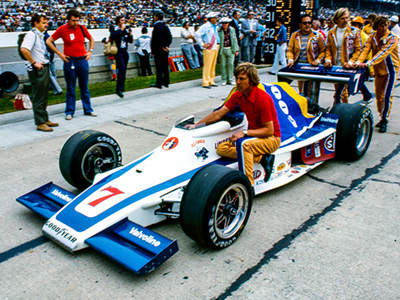
The new Lindsey Hopkins Lightning-Offy at the Indy 500 in 1976. Copyright Richard Deming 2016. Used with permission.
New for Lindsey Hopkins as the #7 Hopkins entry for Roger McCluskey at the Indy 500 in 1976. Raced by McCluskey from Michigan in July to the end of the season, qualifying second at Ontario and at Michigan in September but not actually finishing a race higher than fifth. Sold to Rolla Vollstedt for Janet Guthrie to drive in 1977 as his #27 Bryant Air Conditioning entry. Guthrie qualified for the Indy 500, and also raced the car at Pocono and Ontario, and by Bob Harkey and Dick Simon at other races. Sold to Phil Threshie for 1978 but crashed at Michigan and wrecked again at Ontario, its final race. Later owned by Nick Pappas (Oregon City, OR) and sold by him to Bob Boyce (Michigan City, IN). Later to Bob McConnell (Urbana, OH). Still in McConnell's collection in October 2014.
Driven by: Roger McCluskey, Janet Guthrie, Bob Harkey, Dick Simon and Phil Threshie. First race: Indianapolis Motor Speedway (R3), 30 May 1976. Total of 18 recorded races.
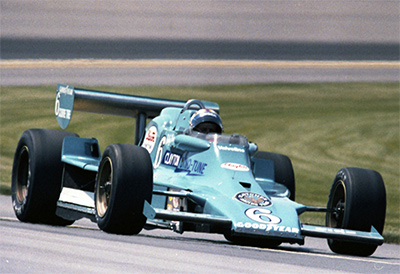
Bobby Unser in Fletcher Racing's Cobre Tire Lightning at the 1977 Indy 500. Copyright Indianapolis Motor Speedway. Copyright permissions granted for non-commercial use by Indianapolis Motor Speedway.
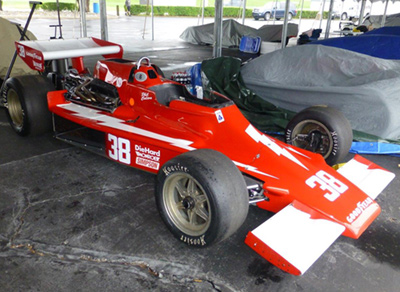
The ex-Phil Caliva Lightning at the Indianapolis Historic Indycar Exhibition in 2017. Copyright Ian Blackwell 2017. Used with permission.
New to Bob Fletcher's Cobre Tire team for Bobby Unser to drive in 1977. After the team's second car was converted to a Cosworth DFX engine late in 1977 but then wrecked by Pancho Carter in testing, this car was also converted to Cosworth power and was raced by Vern Schuppan early in 1978 while Carter recuperated. Carter drove this car at the Indy 500 where it was said by Hungness to be the same car Unser drove in 1977 and also said in press reports to be the car raced by Schuppan at Texas and Trenton prior to Indy. Carter then wrecked this car at Mosport two weeks later and photographs suggest that it was not used again that year. It reappeared for Steve Krisiloff to race at Atlanta in early 1979 and was his intended backup car at the Indy 500, which he raced after withdrawing his primary car. He also raced it at Michigan and Watkins Glen (and probably at the two Trenton races) but Krisiloff then quit the team in frustration. It was not seen in the Fletcher team again but was given by Fletcher to Phil Caliva in 1981 after Caliva had wrecked his McLaren M16C/D in practice at the Indy 500. Caliva built up a "McLightning" combining the monocoque and front section of the Lightning with the rear of the McLaren. He raced this car in 1981, then appeared at Indianapolis, Riverside and Phoenix in 1982 without qualifying for a race, and also raced it at Riverside in August 1983. History then unknown until bought by Dave Roberts (Weddington, NC) in northern Indiana in 2011, on track at the Indianapolis historic event in May 2013, then taken to England for the Goodwood Festival of Speed in 2014 in Budweiser livery. Also displayed at Indianapolis in the same livery in 2015 and at the Coronado Speed Festival in 2015, but by 2017 it had the Budweiser signage removed and Phil Caliva's name on it instead. Sold to Brent Lachelt (Brownsburg, IN), in September 2024.
Driven by: Bobby Unser, Vern Schuppan, Duane "Pancho" Carter, Steve Krisiloff and Phil Caliva. First race: Ontario Motor Speedway (R1), 6 Mar 1977. Total of 23 recorded races.
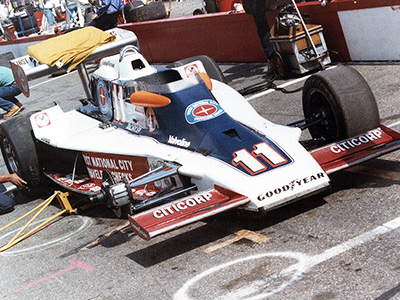
Roger McCluskey's Hopkins Lightning at Pocono in 1977. Copyright Jim Knerr 2020. Used with permission.
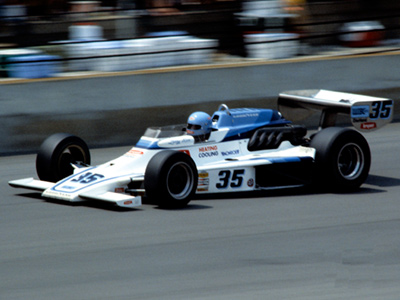
Larry Rice in Patrick Santello's Lightning at the Indy 500 in 1978. Copyright Glenn Snyder 2014. Used with permission.
New to Lindsey Hopkins' team and entered in 1977 as the #11 First National Travelers Check car for driver Roger McCluskey. Hopkins had a second 1977 Lightning, the #10 car used by Lloyd Ruby at the Indy 500, and exactly how these two cars were used in 1977 is not known with certainty. This car was sold to Patrick Santello for 1978 and appeared at the Indy 500 as the #35 car for Larry Rice, but Rice used the team's old 1974 Eagle at other races that season, and the Lightning's only other outing in 1978 was when raced by Vern Schuppan at Texas World Speedway in August. Retained by Santello in 1979 as the #35 S&M Electric entry for Rice and Tim Richmond. Sold to Jack Lang's Pacific Coast Racing for 1980 and raced as the #86 entry by Al Loquasto at Pocono and Jeff Heywood at Ontario. Then unknown until acquired by World Speedway Champion Barry Briggs in 1988, still in "as raced" yellow #86 livery. Later restored to its 1978 #35 livery, and ran at Indy in May and June 2016. Advertised for sale in May 2018. On display at the Grant King Racers Working Race Shop Museum in May 2019. For sale in October 2021 when the owner's name was still given as Barry Briggs.
Driven by: Roger McCluskey, Larry Rice, Vern Schuppan, Tim Richmond, Al Loquasto and Jeff Heywood. First race: Ontario Motor Speedway (R1), 6 Mar 1977. Total of 26 recorded races.
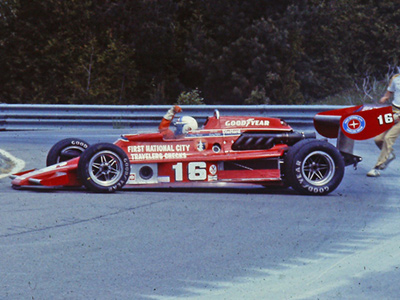
Johnny Parsons in Lindsey Hopkins' Lightning at Mosport Park in 1978. Copyright Jim Allen 2021. Used with permission.
New for Lindsey Hopkins' team and appeared as the team's second entry at the 1977 Indy 500, the #10 '1st National Travel Check' Lightning as raced by Lloyd Ruby. The car was extensively damaged when Ruby hit the wall on lap 34 and burst into flames. It was returned to Autoresearch and completely repaired. The car does not appear to have raced again in 1977, but was retained by the Hopkins team for 1978 alongside the Laydown and was Hopkins' #16 entry for Johnny Parsons at the 1978 Indy 500. Photographs show that Parsons used it at most races that season, with the Laydown only being raced three times. At the final race of the season at Phoenix, Parsons damaged his primary car in practice, and photographs have not yet been found to determine which car he crashed. It is likely to have been this car, with the Laydown by then serving as his backup. It is then distinctly possible that this car was rebuilt as the team's Drake V8 car for 1979, but that remains unproven.
Driven by: Lloyd Ruby and Johnny Parsons Jr. First race: Indianapolis Motor Speedway (R5), 29 May 1977. Total of 13 recorded races.
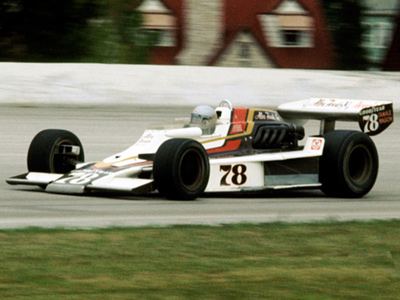
Bobby Olivero in Patrick Santello's Lightning at the Milwaukee in 1977. Copyright Glenn Snyder 2014. Used with permission.
New to Alex Morales for 1977 and entered as the #78 Alex Foods car for Bobby Olivero. Presumably his #78 car for the rest of the season but it is possible that the sister #15 car was also used as the #78 at some points during 1977. Then the #78 Alex Foods car for Max Mosley in 1978 and presumed to be the same #78 car he uses all season but it is again quite likely that the sister car was used somewhere. This was then Pancho Carter's Offy-powered #10 Alex XLNT Foods car at the 1979 Indy 500 and as the sister car had been converted to Drake V8 power, this is presumably the Offy car he used through 1979. As the Drake car was converted to a Cosworth DFX and retained for 1980, this Offy car would be the car sold to John Menard's team and entered as the #28 for Herm Johnson in 1980, still with Offy power. For 1981, the Menard team, led by ex-Parnelli mechanic Dan Cota, extensively modified the car with new ground-effect sidepods and fitted a normally-aspirated Chevrolet stock block engine. The car went well at the Indy 500 but Herm Johnson was bumped. To Larry Walker (Indianapolis, IN) for 1982, and entered by his Timberwood Racers at the Indy 500 in 1982 and 1983 as the #88 Frito-Lay Racer, for Billy Scott in 1982 and Roger Rager in 1983, but did not qualify. Subsequent history unknown.
Driven by: Bobby Olivero, Mike Mosley, Duane "Pancho" Carter, Bob Harkey, Herm A. Johnson, Billy Scott and Roger Rager. First race: Indianapolis Motor Speedway (R5), 29 May 1977. Total of 41 recorded races.
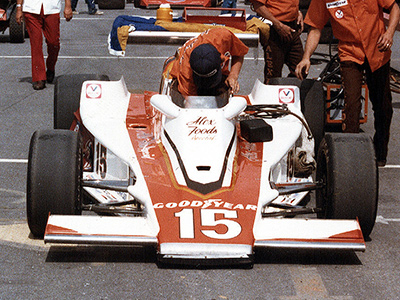
Vern Schuppan's Alex Foods Lightning at Pocono in 1977. Copyright Jim Knerr 2020. Used with permission.
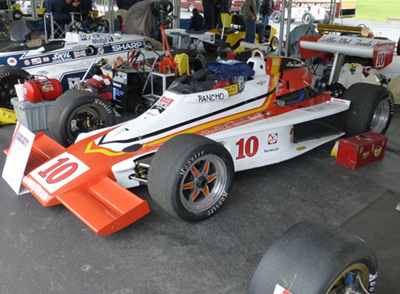
Toney Edwards' Lightning-Drake V8 at the Indianapolis Historic Indycar Exhibition in 2017. Copyright Ian Blackwell 2017. Used with permission.
Chassis 'ROMLIN/4' was new to Alex Morales' Alex Foods team for 1977 as part of a two-car team of Lightnings for Bobby Olivero. This was Olivero's #15 car at the Indy 500 but he raced the #78 backup. This #15 car was then raced by Vern Schuppan later in the season, and also by Pancho Carter at Phoenix. Retained for 1978 and raced by Olivero and then by Mike Mosley, but exactly how the two cars were used that season is unclear. For 1979, this car was fitted with a Drake V8, replacing the original Offy turbo, and was raced by new team driver Pancho Carter as the #10 Alex Foods entry on several occasions. It was then converted to a Cosworth DFX later in 1979, the sister car retaining its original Offy turbo. Morales acquired a Penske PC7 for Carter to drive in 1980 but the Lightning-DFX was retained as a backup and was raced at Pocono in 1980 after the Penske was damaged in practice, at Milwaukee in 1981 and at Watkins Glen in October 1981. Photographs may reveal that it was used more often than this. It was used as a show car thereafter, and was still in the livery of Morales' 1983 #21 entry when acquired by Toney Edwards (Greenwood, Indiana). In January 2016, the car was being restored by Peter Jamie and was to be fitted with a Drake V8. Displayed by Edwards at the Indianapolis Historic Indycar Exhibition in 2017.
Driven by: Billy Vukovich, Bobby Olivero, Vern Schuppan, Duane "Pancho" Carter and Steve Chassey. First race: Pocono International Raceway (R7), 26 Jun 1977. Total of 12 recorded races.
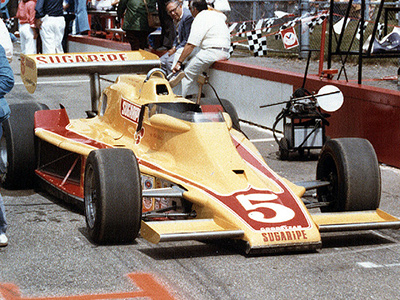
Mike Mosley's Sugaripe Prune Lightning at Pocono in 1977. Copyright Jim Knerr 2020. Used with permission.
New to Jerry O'Connell's team for 1977 and entered as the #5 Sugaripe Prune car for Mike Mosley, with Jud Phillips as chief mechanic. The team used an older 1974 Eagle at some events that year and the Lightning was also raced by Johnny Parsons at Texas. It was fitted with a Cosworth DFX and became the team's spare car for 1978 after O'Connell acquired a McLaren M24 for Wally Dallenbach and would be the Lightning-DFX driven by Billy Vukovich (#32 Sugaripe Prune) as a second team entry at Ontario and finally by Dallenbach (#6 Sugaripe Prune) at Trenton at the end of 1978. Subsequent history unknown.
Driven by: Mike Mosley, Johnny Parsons Jr, Wally Dallenbach and Billy Vukovich. First race: Indianapolis Motor Speedway (R5), 29 May 1977. Total of 7 recorded races.
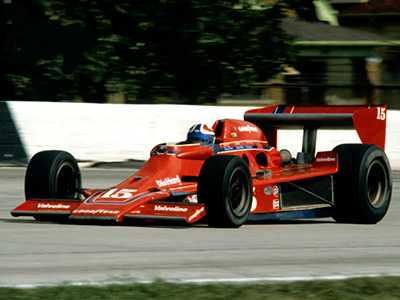
Johnny Parsons in the 'laydown' Lightning at Milwaukee in 1979. Copyright Glenn Snyder 2014. Used with permission.
Designed by Roman Slobodynskyj to have the Offy engine laid on its side, angled just 12 degrees from the horizontal, the 'laydown' Offy was first seen in public at the 1977 California 500. The car required a completely new transmission, designed by Pete Weismmann, and this proved troublesome. Despite the car's speed, Roger McCluskey raced the conventional car at Ontario. New team driver Johnny Parsons drove the car at Ontario and Trenton in early 1978, retiring both times, and then ran it at 197.889 mph in practice at the Speedway before another transmission failure. Photographs show it was at Michigan in September but the car Parsons used to finish in seventh place is now believed to have been his conventional car. Then team focused on the Drake V8 in 1979, but at Indy in May Parsons took the laydown off Hurley Haywood during practice and qualified it ninth. He also qualified it third at Pocono and then - remarkably - finished fourth in it at Milwaukee. Parsons qualified it well again in 1980 but after another retirement, he focused on Hopkins' new ground-effect design. In 1986, the car was donated to the Indianapolis Motor Speedway Museum, and remained with the museum, unrestored, until it was offered for sale in April 2021.
Driven by: Roger McCluskey, Johnny Parsons Jr and Hurley Haywood. First race: Ontario Motor Speedway (R2), 26 Mar 1978. Total of 7 recorded races.
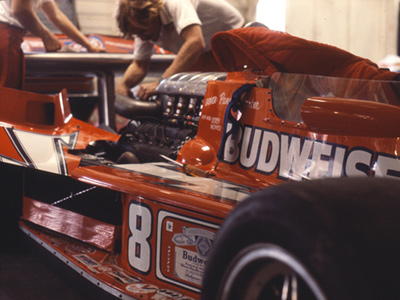
Pancho Carter's Budweiser-sponsored Fletcher Racing Lightning at Mosport Park in 1978. Copyright Wayne Ellwood 2017. Used with permission.
Bob Fletcher's Cobre Tire team had a second 1977 Lightning for Bobby Unser in 1977, but exactly how it was used that season is currently undetermined. This second car was very probably the one converted to take a Cosworth DFX engine later in 1977 and took pole position at Phoenix in October. New driver Pancho Carter then crashed the Lightning-DFX heavily in testing at Phoenix in early December, suffering major injuries. Although it was repaired in time to be entered in the 1978 Indy 500 as the #55 for Vern Schuppan, it did not appear on track. It returned to service at Milwaukee in June after Carter had damaged his other car at Mosport and was his regular car from then until the end of the season. It was raced by Steve Krisiloff at the start of 1979 and was his intended car at the Indy 500 but was withdrawn and he raced his backup. This car did not appear again in the team until Krisloff left the team prior to the Ontario 500. It then became the #55 Fletcher entry for Spike Gehlhausen from Ontario onwards. Fletcher bought a Penske PC7 for 1980 and neither Fletcher Lightning was seen that season. The other Fletcher Lightning went to Phil Caliva for 1981, but the fate of this second car remains unknown.
Driven by: Bobby Unser, Duane "Pancho" Carter, Steve Krisiloff and Spike Gehlhausen. First race: Phoenix International Raceway (R15), 29 Oct 1977. Total of 14 recorded races.
Lightnings in 1978
Nine Lightnings are known to have existed during 1977: the original 1976 car with Janet Guthrie and the Vollstedt team, two with Bob Fletcher's Cobre Tire for Bobby Unser, two with Lindsey Hopkins' team for Roger McCluskey, two with Alex Morales's team, one with Jerry O'Connell's team, and the unraced Offy laydown. Of these, the original car went to Phil Threshie for 1978, both Fletcher cars were retained, one of the Hopkins cars was sold to Patrick Santello for 1978 and the other appears to have been retained, both Alex Morales cars were retained, Jerry O'Connell's car was retained as a spare, and Hopkins also retained the laydown. One additional car appeared in 1978: for Bobby Unser and the Teddy Yip/Dan Gurney AAR team. It is possible that the second of the two 1977 Hopkins cars had been sold to AAR for 1978 and that Hopkins replaced it with a new 1978 car.
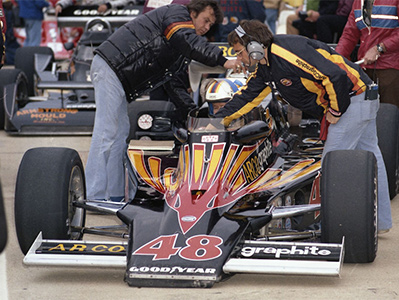
Bobby Unser in AAR's Lightning during practice for the 1978 Indy 500. Copyright Indianapolis Motor Speedway. Copyright permissions granted for non-commercial use by Indianapolis Motor Speedway.
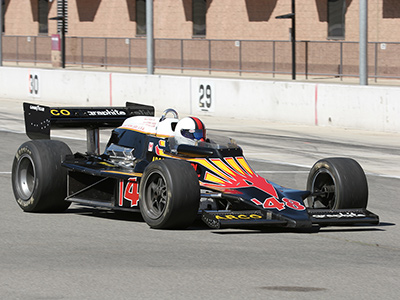
David Morrison in his Indy Lightning at VARA's Route 66 Formula Festival at Fontana Speedway in March 2007. Copyright David S. Morrison 2023. Used with permission.
Chassis "ROMLIN/7" was one of the 1977 Lightnings but its history before it was raced by Bobby Unser for the Teddy Yip/Dan Gurney AAR team in early 1978 is unresolved. It was used for the opening four races of 1978 before being replaced by the team's new Eagle. To Richard Hoffman (Milford, OH) for 1979 and raced by Joe Saldana as the #59 or #69 car during 1979 and 1980. These entry numbers were also used by the team's old 1972 Eagle and exactly how the two cars were used is still to be determined. The Lightning was run in practice at the 1981 Indy 500 with modified sidepods and nose but was crashed by Saldana. It was acquired by Dean Vetrock (Racine, WI) for 1982, but he failed to qualify for the Indy 500 and did not appear in the series again. Vetrock raced this car briefly in the CAT (ex-Can-Am) series in 1987. Four years later, the car was acquired from a Monterey area dealer by a client of Tom Tatalovich Racing Services (Golden Valley, AZ). Tatlovich restored the car to AAR livery, and it was sold at a Barrett-Jackson auction in Scottsdale, Arizona in January 1992. Tom recalls that the buyer was from Hilton Head. By 2002, the car was owned by Larry Wharton, who completed a restoration that year. In 2008, it was bought from Wharton by David S. Morrison (Long Beach, CA). Still with Morrison in April 2023.
Driven by: Bobby Unser, Joe Saldana, George Snider, Lee Kunzman and Dean Vetrock. First race: Phoenix International Raceway (R1), 18 Mar 1978. Total of 19 recorded races.
Lightnings in 1979
Ten Lightnings built to the original 1976 pattern had raced in 1978: the original 1976 car had last been seen when crashed by Phil Threshie at Ontario in 1978; both of the Fletcher cars had stayed with the Fletcher operation for 1979; 'the first Hopkins car' was retained by Pat Santello; 'the second Hopkins car' had not been seen since the end of 1978; both Morales cars were both retained by the Alex Foods team for 1979; 'the O'Connell car' was last seen at the end of 1978; the AAR car went to Richard Hoffman; and the Laydown car was still with Hopkins.
One "new" car appeared, part of the Hopkins team and fitted with new bodywork and a Drake V8 engine. It is distinctly possible that this was the second of the two Lightnings used by the Hopkins team during 1978. After this car failed to qualify for the Indy 500, Hopkins and Roman Slobodynskyj parted company, the designer moving to Ted Field's Interscope team to design new cars for Danny Ongais to drive. Hopkins commissioned Dave Klym's FABCAR operation to build a new generation of Lightnings for 1980 designed by Dave Bruns.
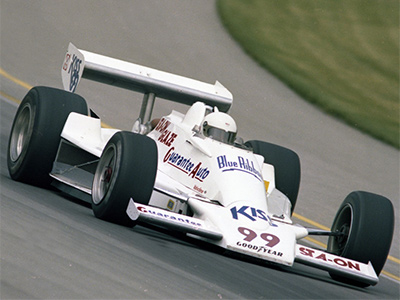
Hurley Haywood in the #99 Hopkins Lightning during practice for the 1980 Indy 500. Copyright Indianapolis Motor Speedway. Copyright permissions granted for non-commercial use by Indianapolis Motor Speedway.
For the 1979 season, Lindsey Hopkins' team had a new blue #15 Lightning fitted with a Drake V8 engine for Johnny Parsons to drive. This car had several detail differences from the earlier type of Lightnings, including a straighter nose and a fuel filler at shoulder height behind the driver. In the USAC races at the start of the 1979 season, Parsons finished second in this car at Ontario and qualified second at TWS. He started practice at the 1979 Indy 500 in the Drake V8 car but elected to swap cars with teammate Hurley Haywood so the new blue Drake V8 car became Haywood's #51 entry. Haywood went faster than Parsons in both cars and was looking likely to qualify well when engine failures ruined both qualifying attempts. George Snider later drove this car at Pocono as the #51. For the 1980 Indy 500, this car was fitted with a turbocharged 207ci (3.4 litre), cast-iron V6 Chevrolet engine built by Ryan Falconer and developing 670bhp on 58ins of boost. After some swapping of cars during practice, Haywood again ended up in this car and after qualifying in 25th position, retired from the race with turbocharger problems. The car was also used by Parsons at Pocono after he wrecked his 1980 Lightning in practice, and also at the two Michigan races. It was also at Indy in 1981 where it was driven in practice by Parsons and Gary Bettenhausen but Parsons was unable to qualify it. The car was not seen again. Current owner Chris Schunk (Wyoming, Ohio) bought it from someone who had acquired it from Hopkins' estate and by 2015 had restored it to 1979 livery with a Drake V8 engine. Still with Schunk in June 2022.
Driven by: Johnny Parsons Jr, Hurley Haywood, George Snider and Gary Bettenhausen. First race: Ontario Motor Speedway (R1), 25 Mar 1979. Total of 6 recorded races.
Lightnings in 1980
By the beginning of 1980, either ten or eleven Lightnings built to the original 1976 pattern had appeared. Of these, the original 1976 car had last been seen when crashed by Phil Threshie at Ontario in 1978; 'the first Fletcher car' was still in the Fletcher Racing stable; 'the second Fletcher car' disappeared at the end of 1979; 'the first Hopkins car' was sold by Pat Santello to Jack Lang for 1980; 'the second Hopkins car' had not been seen since the end of 1978 but may have become the 1979 Drake V8 car; 'the first Morales car' was sold to John Menard's team for 1980; 'the second Morales car' was retained by the Alex Foods team for 1980; 'the O'Connell car' had last been seen at the end of 1978; the AAR car was still with Richard Hoffman; the Laydown car was still with Hopkins; and the car Hopkins fitted with a Drake V8 was retained and fitted with a turbocharged 207ci Falconer Chevrolet V6.
Lightnings in 1981
By the start of the 1981 season, either ten or eleven Lightnings built to the original 1976 pattern had appeared. Of these, the original 1976 car had last been seen when crashed by Phil Threshie at Ontario in 1978; 'the first Fletcher car' went to Phil Caliva for 1981; 'the second Fletcher car' had last been seen in 1979; 'the first Hopkins car' was last seen with Jack Lang in 1980 but did not race again after he owned it; 'the second Hopkins car' had not been seen since the end of 1978 but seems likely to have become Hopkins' 1979 Drake V8 car; 'the first Morales car' was retained by the Menard team for 1981; 'the second Morales car' was again retained by the Alex Foods team as a backup for 1981; 'the O'Connell car' had last been seen at the end of 1978; the AAR car was retained again by the Hoffman team for 1981; the Laydown car was still with Hopkins but no longer in use; and Hopkins' 1979 Drake V8 car, now with a turbo Chevy, was still in the Hopkins stable.
One mystery car appeared, acquired by Doug Schultz and updated significantly for Tom Klausler to drive. If the histories above are correct, the only cars this could be are 'the second Fletcher car'; 'the second Hopkins car' if it did not become the Drake V8 car; and 'the O'Connell car'.
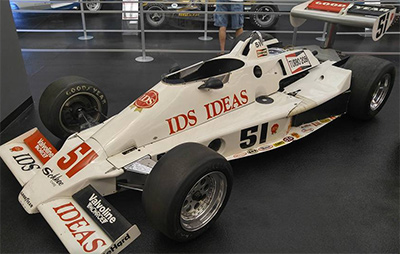
The ex-Tom Klausler Schkee-Lightning at the National Corvette Museum in June 2016. Copyright Jack Douglas 2016. Used with permission.
Tom Klausler raced a "Schkee DB4" at the Indy 500 in 1981, entered by Doug Schulz, fitted with a 209ci Chevrolet V8 turbo built by Dick Jones of Champion, and with Chuck Looper as chief mechanic. The car was clearly a Lightning, and Jones described it in an interview with the Indy Star as "a redesigned 1979 Lightning". It was similar to the cars run by Lindsey Hopkins' team at Indy in 1979 and 1980 but Schultz later described it as a four-year-old (1977) car. Klausler qualified 30th, but retired from the race after only 60 laps with gearbox problems. The car did not race again and at some point joined the Indianapolis Motor Speedway Museum's collection. In 2016 the Lightning was on display in the the National Corvette Museum in Bowling Green, KY. Still in the IMS collection in June 2022.
Driven by: Tom Klausler. First race: Indianapolis Motor Speedway (R1), 24 May 1981. Only one recorded race.
Lightnings from 1982 onwards
Only three of the original 1976-1979 Lightnings made appearances during 1982, Phil Caliva's McLaren-Lightning hybrid, Dean Vetrock ex-AAR car and the heavily-modified ex-Menard car now owned by Timberwood Racers and sponsored by Frito Lay. All three used stock-block Chevrolet-style engines but none of them qualified for a race all season. The Frito Lay car made another Indy 500 appearance in 1983 and again failed to qualify, and the final CART or USAC race start for this group of cars was credited to Caliva at Riverside in August 1983.
Acknowledgements
My thanks to Simmo Iskül, 'gbl', Michael Ferner and Tom Schultz for their help compiling these histories. Also to former and current owners Dean Vetrock, Toney Edwards and Chris Schunk, to Edmunds crew member Bruce Selby, to Chuck Jones, and to Glenn Snyder, Jim Knerr, Richard Deming, Jim Allen, Wayne Ellwood and Ian Blackwell for the use of their photographs.
If you can add to our understanding of these cars, or have photographs that we can use, please email Allen at allen@oldracingcars.com.
These histories were last updated on .